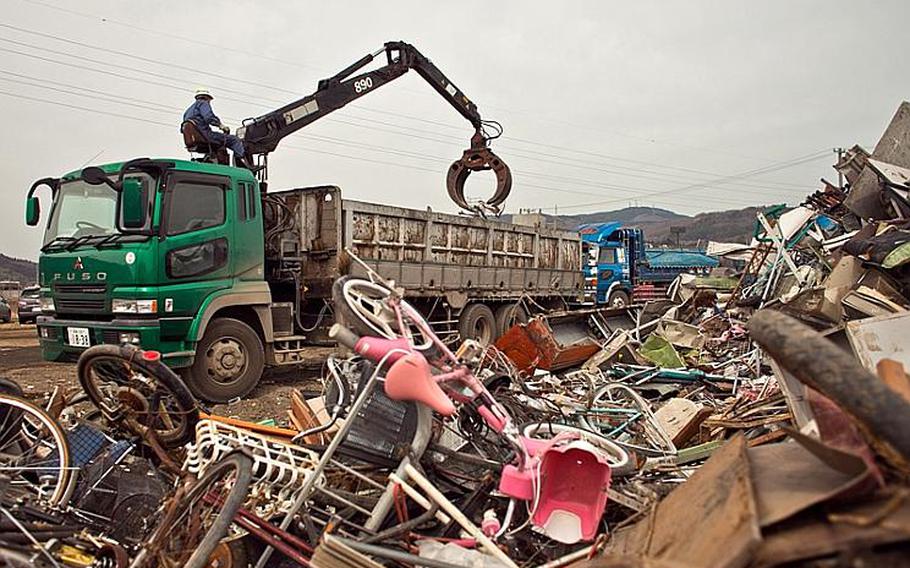
A city worker moves heaps of bikes and other scrap metal into a truck at one of two temporary tsunami-related trash dump sites in Ishinomaki, Japan. (Nathan A. Bailey/Stars and Stripes)
SENDAI, Japan — It’s everywhere. In all shapes and sizes. And it will take years to dispose of it all.
Despite a unified effort by Japanese and U.S. troops, officials estimate it will take three to six years to rid Japan of 20 million tons of debris scattered by the March 11 tsunami.
“We’ve been moving debris that ranges from trash to cars - anything that is in the way that doesn’t need to be there,” said Army Spc. Gary Pritt, 22, of New Smyrna Beach, Fla., while shoveling a tar-like substance from behind a school baseball diamond in Ishinomaki on Thursday.
The tsunami debris is strewn across six prefectures, from Aomori in the north to Chiba in the south, according to Japan’s Environment Ministry.
“At this time, no estimate is available on how much it would cost to dispose all of it,” said Koji Ono, spokesman for the ministry’s Waste Management Division. While local governments are responsible for the clean-up, Japan’s central government will pay for it, he said.
The bulk of the debris is in Miyagi Prefecture, where the local government estimates 18 million tons has been scattered.
In Ishinomaki, the city where most of the U.S. troops are now working, officials said Friday that they hope to burn or bury much of the debris.
Dump trucks cart away the debris from the coastal areas of Ishinomaki to two newly established recycling centers.
At one of them, in a large area of wasteland next to a sports complex where U.S. and Japanese soldiers have established a base for relief operations, truck after truck unloaded the trash Thursday.
Watanabe Seichi, 55, who directed traffic on the city’s streets before the disaster, was using red and green flags to show the trucks where to dump their loads.
In one area, thousands of thin Japanese mattresses were stacked in a massive pile. Nearby, bits of wooden houses formed what looked like the world’s biggest bonfire. In another, a worker used a machine with a giant mechanical claw to load twisted scrap metal in a truck headed to the local steel mill. And on the far side of the facility, a line of broken refrigerators, televisions, microwave ovens and other appliances stretched several hundred yards.
“They bring all the debris here and we sort it,” he said. adding that there’s another tsunami debris recycling facility near Ishinomaki’s badly damaged port.
Seichi said workers attempting to recycle the debris are struggling with the large volume of household trash washed into the streets by the tsunami.
“It’s a real problem because it smells and people haven’t sorted it properly,” he said. “Japanese people normally recycle most of their trash, but this is all messed up.”
And then there’s the automobiles.
The March 11 great wave picked up thousands of cars from coastal areas of northern Japan and dumped them in some unlikely spots.
In Sendai on Friday, a small car balanced precariously on top of a vending machine. Others cars were scattered in a grove of trees or rested upside down amid tombstones in a cemetery. In an area of the port labeled “motor pool,” workers had arranged hundreds of battered vehicles in neat lines.
Officials put stickers on vehicles that still have license plates informing the owners that they must have them towed. Vehicles without license plates are taken to a junk yard, Seichi said.
All that was left of Seichi’s home and possessions after the tsunami were the building’s foundations. He said he was grateful he and his family survived. And he’s also realistic when he comes to the chances of him finding his belongings in the debris he helps sort through.
“I think my home and possessions are out in the ocean now,” he said.
Elena Sugiyama contributed to this story.